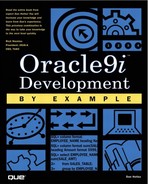Answers to Chapter 4
 | Reviewing It |
| 1: | Why does the author recommend using a prefix on all the application database objects? |
| A1: | To quickly identify related application objects when querying DBA_OBJECTS |
| 2: | Why does the author use a database trigger to maintain the data in the INSERT_USER, INSERT_DATE, UPDATE_USER, and UPDATE_DATE? |
| A2: | To automatically maintain the data in these fields no matter what tool is used to insert or update these objects |
| 3: | Why does the author spool a .log file out of the INSTALL scripts? |
| A3: | To capture any error and/or warning statements issued during the execution of the script |
| 4: | What is the ST_INV_SEQ useful for? |
| A4: | To help insure a unique ST_INV_ID in the ST_INVENTORY table |
| 5: | What is the difference between an inline and an out-of-line constraint. |
| A5: | An inline constraint is one that is defined where the field that it applies to is defined. An out-of-line constraint is one that is added with separate syntax at a later time. |
 | Checking It |
| 1: | An ERD crows foot pointing towards an object means:
|
| A1: | b |
| 2: | A straight line in an ERD diagram indicates a one-to-one row relationship between the two objects. True/False |
| A2: | True |
| 3: | Creating multiple tablespaces is useful for:
|
| A3: | d |
| 4: | Is SQL*Plus the only tool useful in creating database objects? True/False |
| A4: | False |
| 5: | What is the purpose of :new.inv_insert_user := :old.inv_insert_ user; in the Listing 4.3.
|
| A5: | a. |
 | Applying It |
Independent Exercise 1:
- Download both INSTALL scripts from www.quepublishing.com.
- Review the Oracle9i directory structure on your computer.
- Edit INSTALL_Sales_Tracking_Database.sql and validate/change the file locations on the various CREATE TABLESPACE statements
- Execute the edited INSTALL_Sales_Tracking_Database.sql to create the book example Tablespaces.
- Review the LOG file for any errors.
Independent Exercise 2:
- Review the INSTALL_Sales_Trackng_Objects.sql.
- Execute the INSTALL_Sales_Tracking_Object.sql to create the book example objects.
- Review the LOG file for any errors.
Independent Exercise 3:
- Download the EXPORT_Sales_Tracking.dmp file from www.quepublishing.com.
- IMPORT the EXPORT_Sales_Tracking.dmp file.
..................Content has been hidden....................
You can't read the all page of ebook, please click here login for view all page.
